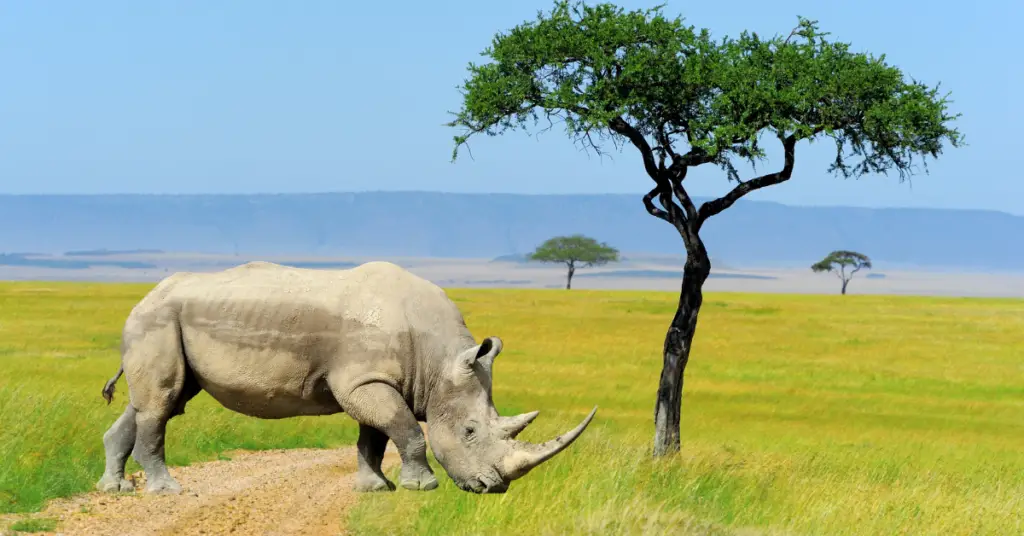The northern subspecies were found in a past, west of the Upper Nile River, from northwestern Uganda and the northeastern Democratic Republic of the Congo northward into southern Sudan and adjacent parts of the Central African Republic and the southern border of Chad.
A feature of the historical distribution of the species as a whole is the limitation of large rivers, possibly due to its limited ability to swim. White Rhinos formerly occurred through much of East Africa, as is attested by abundant fossil remains in early to mid-Pleistocene deposits in places like Olduvai Gorge.
Teeth are found on the soil surface in Kenya, and rock paintings in Tanzania, suggesting that the species persisted in East Africa until a few thousand years ago. They had an extended range in North Africa during the early Holocene.
Current distribution of Northern White Rhino
South Africa remains the stronghold of this subspecies, with significant populations at Kruger N. P.and Hluhluwe – iMfolozi, but also present in many protected areas and private reserves across the country. There are also smaller reintroduced populations within the species’ historic range in Namibia, Botswana, Zimbabwe, Swaziland, and Mozambique.
Populations were introduced out of the range of the previous subspecies in Kenya, Uganda, and Zambia. An introduced population in Côte d’Ivoire is considered semi-active. Northern subspecies are now extinct in Uganda, Chad, Central African Republic, and at least until 2006 it survived in the wild only as a small remnant in Garamba N.P. in DR Congo.
The subspecies is now probably extinct in the wild. Reports of rhinos surviving in S Sudan are unconfirmed; none were reported during the survey by Fay et al.(2007).
Habitat of Northern White Rhino
In the wild, the last remaining northern white rhinos live on the grassy plains of Kenya, Africa. Historically, populations ranged from Kenya and Ethiopia in the east to Nigeria and Ghana in the west. The Northern White Rhino (NWR) used to range over parts of northwestern Uganda, southern Chad, southwestern South Sudan, the eastern part of the Central African Republic, and the northeastern Democratic Republic of the Congo.
The previous population in Garamba, the national park in the northeastern Democratic Republic of the Congo is now considered probably extinct, although systematic field surveys are likely and since 2006 new foot patrols and aerial reconnaissance of live rhinos have been observed, and no new signs since.
There continue to be unconfirmed reports/rumors of rhinos in southern Sudan but these have not been reliably confirmed and wildlife hunting in this area has increased, so it is unlikely to survive much longer.
The last four potential breeders of northern white rhinos in captivity at Dvur Kralove Zoo in the Czech Republic have been relocated to a private conservancy in Kenya in the hope this would stimulate their breeding but despite mating, no offspring were produced before the death of the two old males, and it seems that the females do not reproduce despite attempts.
IVF Advanced cellular techniques offer the possibility of increasing the genetic diversity of founders because there are cells and tissues stored by more NWRs than natural gametes. If induced pluripotent stem cells (iPSCs) can be used to produce primordial germ cells, then it is possible to create oocytes and sperm from other dead NWRs.
If IVF can be developed with embryos implanted into SWR surrogates, then it should be possible to produce NWR calves. The latter in adulthood could be used to create a self-sustaining rhino population. In vitro fertilization crosses can also be attempted. In time if such assisted reproductive methods can be successfully developed then once numbers have built up sufficiently some of these animals could be reintroduced to safe areas of the former range or close to the former range in East Africa.
There is no guarantee that these techniques will be successful, but progress has been made in creating embryos in the laboratory at this stage.

Erzsebet Frey (Eli Frey) is an ecologist and online entrepreneur with a Master of Science in Ecology from the University of Belgrade. Originally from Serbia, she has lived in Sri Lanka since 2017. Eli has worked internationally in countries like Oman, Brazil, Germany, and Sri Lanka. In 2018, she expanded into SEO and blogging, completing courses from UC Davis and Edinburgh. Eli has founded multiple websites focused on biology, ecology, environmental science, sustainable and simple living, and outdoor activities. She enjoys creating nature and simple living videos on YouTube and participates in speleology, diving, and hiking.

